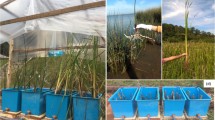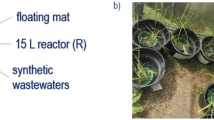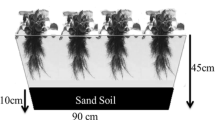Abstract
The aims of this work were to evaluate the effects of P and N on the tolerance and root morphometry of Typha domingensis plants, and their implication in removal efficiency in floating treatment wetlands (FTWs). Pilot-scale plastic reactors containing plants, sediment, and tap water were arranged. FTWs consist of a plastic net, and buoyancy was provided by a PVC frame. After plant acclimation, 38 L of the synthetic effluent containing 10 mg L−1 N + 2 mg L−1 P was added to the reactors as follows: reactor A (with FTWs), reactor B (without FTWs), reactor BC (biological controls), and reactor CC (chemical control). Reactors were arranged in triplicate. During the experiment, three effluent dumps were made. The removals of SRP and TP were significantly higher in reactor A than in reactor B. N-NH4+ removal was not significantly different between reactors A and B, while N-NO3− removal from water was higher in reactor A than in reactor B. At the end of the experiment, chlorophyll concentration and aerial and submerged (roots and rhizomes) biomass increased significantly in reactor A. TP concentrations were not different between rhizomes and leaves, while the lowest concentrations were observed in roots. The TKN in tissues was significantly higher in roots and rhizomes than in aerial parts. In plants exposed to the experimental solution, the internal and external root morphology changed. The use of FTWs is a promising strategy for the sustainable treatment of nutrient polluted water bodies.







Similar content being viewed by others
Data availability
The data that support the findings of this study are available from the corresponding author, MdlMM, on reasonable request.
Abbreviations
- BC:
-
Biological control
- CC:
-
Chemical control
- DO:
-
Dissolved oxygen
- Eh:
-
Redox potential
- FTWs:
-
Floating treatment wetlands
- OM:
-
Organic matter
- PVC:
-
Polyvinyl chloride
- RGR:
-
Relative growth rate
- SRP:
-
Soluble reactive phosphorus
- CWs:
-
Constructed wetlands
- TP:
-
Total phosphorus
- TKN:
-
Total Kjeldahl nitrogen
- CSA:
-
The cross-sectional areas
- NV:
-
Number of vessels
- HRT:
-
Hydraulic residence time
References
APHA AWWA, WEF (2012) Standard methods for the examination of water and wastewater, 22nd edition. American Public Health Association, Washington DC
Awad J, Hewa G, Myers RB, Walker C, Lucke T, Akyol B, Duan X (2022) Investigation of the potential of native wetland plants for removal of nutrients from synthetic stormwater and domestic wastewater. Ecol Eng 179:106642
Baldovi AA, de Barros R, Aguiar A, Benassi RF, Vymazal J, Araujo de Jesus T (2021) Phosphorus removal in a pilot scale free water surface constructed wetland: hydraulic retention time, seasonality and standing stock evaluation. Chemosphere 266:123983
Bialowiec A, Janczukowicz PF, Randerson W (2011) Nitrogen removal from wastewater in vertical flow constructed wetlands containing LWA/gravel layers and reed vegetation. Ecol Eng 6:897–902
Bodin H, Persson J, Englund JE, Milberg P (2013) Influence of residence time analyses on estimates of wetland hydraulics and pollutant removal. J Hydrol 501. https://doi.org/10.1016/j.jhydrol.2013.07.022
Bonilla I (2008) Introducción a la nutrición mineral de las plantas. Los elementos minerales. In: Azcon-Bieto J, Talón M (eds) Fundamentos de Fisiología Vegetal. McGraw Hill-Ube, Madrid, pp 103–121
Borne KE (2014) Floating treatment wetland influences on the fate and removal performance of phosphorus in stormwater retention ponds. Ecol Eng 69:76–82
Chen Z, Cuervo DP, Müller JA, Wiessner A, Köser H, Vymazal J, Kästner M, Kuschk P (2016) Hydroponic root mats for wastewater treatment – a review. Environ Sci Pollut Res 23(16):15911–15928
Chen D, Gu X, Zhu W, He S, Wu F, Huang J, Zhou W (2019) Denitrification-and anammox-dominant simultaneous nitrification, anammox and denitrification (SNAD) process in subsurface flow constructed wetlands. Biores Technol 271:298–305
D’Ambrogio de Argüeso A (1986) Manual de técnicas en histología vegetal. I–IV. Buenos Aires, Hemisfero Sur
Di Luca GA, Mufarrege MM, Sánchez GC, Hadad HR, Maine MA (2011) P distribution in different sediment fractions of a constructed wetland. Water Sci Technol 63(10):2374–2380
Di Luca GA, Mufarrege MM, Hadad HR, Maine MA (2019) Nitrogen and phosphorus removal and Typha domingensis tolerance in a floating treatment wetland. Sci Tot Environ 650:233–240
Fonder N, Headley T (2010) Systematic nomenclature and reporting for treatment wetlands. In: Vymazal J (ed) In: Water and nutrient management in natural and constructed wetlands. Dordrecht. Netherlands. Springer, pp 191–220
Giordano M, Beardall J, Raven JA (2005) CO2 concentrating mechanisms in algae: mechanisms, environmental modulation, and evolution. Ann Rev Plant Biol 56:99–131
Golterman HL (1995) The labyrinth of nutrient cycles and buffers in wetlands: results based on research in the Camargue (Southern France). Hydrobiologia 315(1):39–58
Hadad H, Maine MA (2001) Efectos del fósforo sobre el crecimiento y competencia de Salvinia herzogii de la Sota (Salviniaceae) y Pistia stratiotes L. (Araceae). Rev FABICIB 5:49–56
Hadad HR, Mufarrege MM, Di Luca GA, Maine MA (2018) Long-term study of Cr, Ni, Zn, and P distribution in Typha domingensis growing in a constructed wetland. Environ Sci Pollut Res 25:18130–18137
Headley TR, Tanner CC (2012) Constructed wetlands with floating emergent macrophytes: an innovative stormwater treatment technology. Crit Rev Environ Sci Technol 42(21):2261–2310
Hegazy AK, Adbel Ghani NT, El-Chaghaby GA (2011) Phytoremediation of industrial wastewater potentiality by Typha domingensis. Int J Environ Sci Tech 8(3):639–648
Huth I, Walker C, Kulkarni R, Lucke T (2021) Using constructed floating wetlands to remove nutrients from a waste stabilization pond. Water 13(13):1746
Jones TG, Willis N, Gough R, Freeman C (2017) An experimental use of floating treatment wetlands (FTWs) to reduce phytoplankton growth in freshwaters. Ecol Eng 99:316–323
Kyambadde J, Kansiime F, Gumaelius L, Dalhammar G (2004) A comparative study of Cyperus papyrus and Miscanthidium violaceum based constructed wetlands for wastewater treatment in a tropical climate. Water Res 38:475–485
Li D, Zheng B, Liu Y, Chu Z, He Y, Huang M (2018) Use of multiple water surface flow constructed wetlands for non-point source water pollution control. Appl Microbiol Biotechnol 102:5355–5368
Lorenzen B, Brix H, Mendelssohn I, McKee K, Li Miao S (2001) Growth, biomass allocation and nutrient use efficiency in Cladium jamaicense and Typha domingensis as affected by phosphorus and oxygen availability. Aquat Bot 70: 117–133
Lucke T, Walker C, Beecham S (2019) Experimental designs of field-based constructed floating wetland studie: a review. Sci Total Environ 660:199–208
Maine MA, Hadad HR, Sánchez GC, Di Luca GA, Mufarrege MM, Caffaratti SE, Pedro MC (2017) Long-term performance of two free-water surface wetlands for metallurgical effluent treatment. Ecol Eng 98:372–377
Maine MA, Suñé N, Hadad RH, Sánchez GC, Bonetto C (2009) Influence of vegetation on the removal of heavy metals and nutrients in a constructed wetland. J Environ Manag 90:355–363
Marschner H (2012) Mineral nutrition of higher plants, 3rd edn. Academic Press, London
Minkina T, Fedorenko G, Nevidomskaya D, Fedorenko A, Chaplygin V, Mandzhieva S (2018) Morphological and anatomical changes of Phragmites australis Cav. due to the uptake and accumulation of heavy metals from polluted soils. Sci Tot Environ 636:392–401
Mufarrege MM, Hadad HR, Maine MA (2009) Response of Pistia stratiotes to heavy metals (Cr, Ni, and Zn) and phosphorous. Arch Environ Contam Toxicol 58(1):53–61
Mufarrege MM, Hadad HR, Di Luca GA, Maine MA (2014) Metal dynamics and tolerance of Typha domingensis exposed to high concentrations of Cr, Ni and Zn. Ecotoxicol Environ Saf 105:90–96
Mufarrege MM, Hadad HR, Di Luca GA, Maine MA (2015) The ability of Typha domingensis to accumulate and tolerate high concentrations of Cr, Ni and Zn. Environ Sci Pollut Res 22:286–292
Murphy J, Riley J ( 1962) A modified single solution method for determination of phosphate in natural waters. Anal Chem Acta 27:31–36
Nichols P, Lucke T, Drapper D, Walker C (2016) Performance evaluation of a floating treatment wetland in an urban catchment. WaterSA 8(6):244
Pavlineri N, Skoulikidis N, Tsihrintzis V (2017) Constructed floating wetlands: a review of research, design, operation and management aspects, and data meta-analysis. Chem Eng J 308:1120–1132
Qin S, Zhang X, He S, Huang J (2021) Improvement of nitrogen removal with iron scraps in floating treatment wetlands. Environ Sci Poll Res 28:17878–17890
Richardson CJ (1999) The role of wetlands in storage, release, and cycling of phosphorus on the landscape: a 25-year retrospective. In: Reddy KR, O’Connor GA, Schelske CL (eds) Phosphorus biogeochemistry in subtropical ecosystems. CRC Press, Boca Raton, Fl, pp 47–68
Singh A, Malaviya P (2019) Chromium phytoaccumulation and its impact on growth and photosynthetic pigments of Spirodela polyrrhiza (L.) Schleid. on exposure to tannery effluent. Environ Sust 2:157–166
Sesin V, Davy CM, Freeland JR (2021) Review of Typha spp. (cattails) as toxicity test species for the risk assessment of environmental contaminants on emergent macrophytes. Environ Pollut 284:117105
Sharma R, Vimazal J, Malaviya P (2021) Application of floating treatment wetlands for stormwater runoff: a critical review of the recent developments with emphasis on heavy metals and nutrient removal. Sci Tot Environ 146094
Schwammberger P, Lucke T, Walker C, Trueman SJ (2019) Nutrient uptake by constructed floating wetland plant during the construction phase of an urban residential development. Sci Total Environ 677:390–403
Stefanakis A, Akratos CS, Tsihrintzis VA (2014) Vertical flow constructed wetlands. 1st Edn. Elsevier
Stewart F, Mulholland T, Cunningham A, Kania B, Osterlund M (2008) Floating islands as an alternative to constructed wetlands for treatment of excess nutrients from agricultural and municipal wastes – results of laboratory-scale tests. Land Contam Reclam 16(1):25–33
Sun S, Gao L, He S, Huang J, Zhou W (2019) Nitrogen removal in response to plants harvesting in two kinds of enhanced hydroponic root mats treating secondary effluent. Sci Tot Environ 670:200–209
Tang Y, Harpenslager SF, Van Kempen MML, Verbaarschot EJH, Laury MJ, Loeffen M, Roelofs JGM, Smolders AJP, Lamers LPM (2017) Aquatic macrophytes can be used for wastewater polishing but not for purification in constructed wetlands. Biogeosciences 14:755–766
Tanner CC, Headley TR (2011) Components of floating emergent machrophyte treatment wetland influencing of storm water pollutants. Ecol Eng 37:474–486
Teng C-J, Leub S-Y, Ko C-H, Fan C, Sheu Y-S, Hu H-Y (2012) Economic and environmental analysis of using constructed riparian wetlands to support urbanized municipal wastewater treatment. Ecol Eng 44:249–258
USEPA (1994) Method 200.2: Sample preparation procedure for spectrochemical determination of total recoverable elements. Rev.2.8. United State Environmental Protection Agency, Washington D.C
Verschoor AM, Van Dijk MA, Huisman J, Van Donk E (2013) Elevated CO2 concentrations affect the elemental stoichiometry and species composition of an experimental phytoplankton community. Fresh Biol 58:597–611
Vymazal J (2007) Removal of nutrients in various types of constructed wetlands. Sci Tot Environ 380(1–3):48–65
Vymazal J (2011) Plants used in constructed wetlands with horizontal subsurface flow: a review. Hydrobiologia 674:133–156
Wahl S, Ryser P, Edwards PJ (2001) Phenotypic plasticity of grass root anatomy in response to light intensity and nutrient supply. Ann Bot 88:1071–1078
Weragoda SK, Jinadasa KBSN, Zhang DQ, Gersberg RM, Tan SK, Tanaka N, Jern NW (2012) Tropical application of floating treatment wetlands. Wetlands 32:955–961
Westlake DF (1974) Macrophytes. In: Vollenweider RA (ed) A manual on methods for measuring primary production in aquatic environments, IBP Handbook Nº 12, 2nd edn. Blackwell Scientific Publications, Oxford, International Biological Programme, pp 32–42
Xie Y, Yu D (2003) The significance of lateral roots in phosphorus acquisition of water hyacinth (Eichhornia crassipes). Aquat Bot 75:311–321
Yang X, Wu X, Hao H, He Z (2008) Mechanisms and assessment of water eutrophication. J Zhejiang Univ Sci B 9(3):197–209
Zhou X, Wang G (2010) Nutrient concentration variations during Oenanthe javanica growth and decay in the ecological floating bed system. J Environ Sci 22(11):1710–1717
Funding
Funding for this work was provided by Consejo Nacional de Investigaciones Científicas y Técnicas (CONICET, Argentina), Universidad Nacional del Litoral (UNL, Argentina), and Agencia Nacional de Promoción Científica y Tecnológica (ANPCyT, Argentina).
Author information
Authors and Affiliations
Contributions
MdlMM: conceptualization, methodology, formal analysis, investigation, writing—original draft, writing—review and editing, visualization, supervision. GADL: conceptualization, methodology, formal analysis, investigation, writing—original draft, writing—review and editing, visualization, supervision. AAC: formal analysis, investigation, writing—review and editing. HRH: conceptualization, methodology, resources, writing—review and editing, visualization, supervision, project administration, funding acquisition. MAM: conceptualization, methodology, resources, writing—review and editing, visualization, supervision, project administration, funding acquisition. MAC: formal analysis, investigation, writing—review and editing. EN: formal analysis, investigation, writing—review and editing.
Corresponding author
Ethics declarations
Ethics approval
The work did not generate negative impacts on the environment. No current bioethical standards were violated.
Consent to participate
Author and all co-authors agree to submit the present research work in the previously mentioned journal and disclose that it has not been published previously and that it is not under consideration for publication elsewhere.
Consent for publication
Author and all co-authors agree to publish the present research work in the journal.
Conflict of interest
The authors declare no competing interests.
Additional information
Responsible Editor: Alexandros Stefanakis
Publisher's note
Springer Nature remains neutral with regard to jurisdictional claims in published maps and institutional affiliations.
Rights and permissions
Springer Nature or its licensor (e.g. a society or other partner) holds exclusive rights to this article under a publishing agreement with the author(s) or other rightsholder(s); author self-archiving of the accepted manuscript version of this article is solely governed by the terms of such publishing agreement and applicable law.
About this article
Cite this article
Mufarrege, M.d.M., Di Luca, G.A., Carreras, Á.A. et al. Response of Typha domingensis Pers. in floating wetlands systems for the treatment of water polluted with phosphorus and nitrogen. Environ Sci Pollut Res 30, 50582–50592 (2023). https://doi.org/10.1007/s11356-023-25859-z
Received:
Accepted:
Published:
Issue Date:
DOI: https://doi.org/10.1007/s11356-023-25859-z




